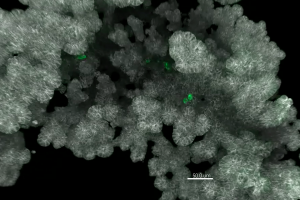Organ Design 101: Discovering the rules for building a pancreas
Posted by jturan91, on 19 November 2015

As we develop from wads of cells to fully formed humans, each of our organs goes through intricate processes to achieve the right combination and number of cells arranged in the proper way.
Research published in PLoS Biology by Yung Hae Kim and her colleagues looks at the development of our hormone-oozing pancreas, which assists digestion. They wanted to know how the cells become different cell types. Cells in developing organs begin without specificity and over time turn into various cell types upon receiving the right signals.
The beauty of this research, a part of the puzzle of how we form, is encompassed in the video below. This moving three-dimensional image is really hundreds of two-dimensional images merged together. The cells shown are a chunk of the pancreas, lit up in white, green, blue, and magenta. Our cells are constantly churning out proteins that they use to carry out their functions. It is these proteins that the colours are marking. And the colours carry meaning. Blue and magenta indicate two different kinds of cells, distinguished by a specific protein that only that type of cell makes.
From this colorful three-dimensional clip, Kim and her team looked at whether the cells of the pancreas are ones that can produce hormones, or cells that have not specialized to this function. Further down the line, knowledge about when and how the cells become hormone-secreting ones could be important for diabetes research. It is cells of the pancreas that produce the insulin we need to control blood sugar levels. Perhaps we could incite cells that haven’t specialized to make insulin, to secrete it.
For more information on diabetes and stem cells
- http://www.eurostemcell.org/factsheet/diabetes-how-could-stem-cells-help
- http://www.eurostemcell.org/resource/stem-cells-and-diabetes
- http://www.eurostemcell.org/stem-cells-and-diabetes
This research is from the lab of Anne Grapin-Botton, Danstem, part of the HumEn consortium, working towards making fully functional beta cells for diabetes therapy.


 (1 votes)
(1 votes)